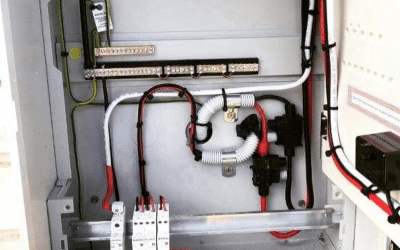In the bustling city of Brisbane, where urban development is not just a sign of growth but a necessity, electrical planning emerges as a cornerstone of modern construction projects. This initial phase in any development is not just about laying out where the wires and switches will go; it’s about ensuring the functionality, safety, and energy efficiency of new buildings, which ultimately enhances the quality of life for residents and businesses alike.
Electrical planning, a critical component of architectural and construction endeavours, involves far more than the basic installation of electrical systems. In today’s fast-evolving urban landscape, it represents a detailed orchestration of design, technology integration, and strategic foresight. As Brisbane continues to expand and embrace new technological advancements, the role of electrical planning becomes increasingly complex and indispensable.
Effective electrical planning ensures that all building systems function harmoniously, from lighting to heating and cooling systems, and now more than ever, to smart home technologies and renewable energy systems. This meticulous process helps prevent operational failures and costly maintenance issues that can arise from poorly designed electrical infrastructures. Moreover, it addresses the essential safety standards that protect both the physical property and the people within from electrical hazards.
However, the benefits of robust electrical planning extend beyond safety and functionality. In a world where energy efficiency and sustainability are paramount, the strategic integration of renewable energy systems into building designs is crucial. Electrical planning today involves adapting to the demands of energy-efficient practices that not only meet but exceed the regulatory compliance standards set forth by Brisbane’s local authorities.
As we delve deeper into the subject, we will explore how advanced planning tools and practices are not just beneficial but necessary for crafting aesthetically appealing and technologically equipped environments. By understanding the intricacies of electrical planning, stakeholders from developers and architects to homeowners can appreciate the profound impact meticulous electrical design has on the overall success of construction projects in Brisbane. This awareness and knowledge pave the way for the adoption of innovative solutions that lead to smarter, safer, and more sustainable urban environments.
Understanding Electrical Planning
Electrical planning is a crucial, often complex component of the construction process that entails designing the electrical systems of a building to ensure they are safe, efficient, and capable of accommodating the building’s needs. It is an integral part of the early planning stages that aligns the electrical infrastructure with the architectural design, ensuring that every element from lighting to power outlets is precisely where it needs to be for optimal functionality and aesthetic value.
The process begins with a detailed assessment of the building’s power needs. This involves determining the amount and type of power required for various uses within the building, including domestic, commercial, or industrial purposes. Electrical planners must consider current and future needs, anticipating changes in usage and technology advancements that may affect power consumption and distribution.
Following this, the layout considerations are addressed. This step involves mapping out where electrical components such as wires, outlets, service panels, and light fixtures will be located. The layout must consider both functionality and design aesthetics, ensuring that electrical systems are accessible for maintenance while discreetly integrated into the building’s overall design. Safety is paramount, with strict adherence to Brisbane’s building codes and regulations influencing every decision.
The Benefits of Thorough Electrical Plans
A well-thought-out electrical plan brings multiple long-term benefits to construction projects. Firstly, it significantly reduces the likelihood of needing costly modifications after the building is completed. By accurately planning and documenting the electrical systems, contractors can avoid common pitfalls like insufficient power supply to areas, overly congested wiring, and conflicts with other structural elements, which are expensive and time-consuming to rectify later.
Safety is another critical advantage. Thorough electrical plans help prevent accidents and hazards associated with electrical systems, such as fires, shocks, and short circuits. By ensuring that all electrical installations comply with safety standards and regulations, planners help protect not only the physical property but also the lives of those who inhabit or use the building.
Moreover, modern electrical planning embraces the integration of renewable energy sources, such as solar panels and wind turbines, into building designs. This not only aligns with global sustainability trends but also offers economic benefits through energy savings and potential government incentives. The strategic inclusion of these technologies in electrical plans is becoming a standard practice in Brisbane, reflecting the city’s commitment to reducing its carbon footprint and promoting energy independence.
In summary, electrical planning is more than just a preparatory step in the construction process; it is a strategic endeavour that enhances building functionality, ensures safety, and contributes to sustainability. The forward-thinking integration of renewable energy and the meticulous attention to detail in planning are what set apart successful projects in Brisbane’s dynamic urban landscape.
Essential Considerations for Electrical Planning
When architects and engineers embark on creating electrical blueprints for a new development, several key factors guide their decision-making process. These considerations are critical to ensure that the building’s electrical system is not only efficient but also adaptable and compliant with local regulations.
Load Requirements
One of the primary considerations in electrical planning is understanding the load requirements of the building. This involves calculating the total electrical load that the building will demand at peak usage, which influences the design of circuits, the choice of electrical panels, and the capacity of supply lines. Load calculations must be accurate to prevent system overloads, which can lead to power outages and potential safety risks.
Future Scalability
Future scalability is another crucial factor, especially in rapidly developing urban environments like Brisbane. Electrical systems must be designed with flexibility to accommodate future growth or changes in use. This could mean provisioning for additional capacity in the electrical panels, using modular designs that can be easily expanded, or installing conduits for future wiring needs. Planning for scalability ensures that the building can adapt to technological advancements or increased electrical demands without requiring significant overhauls.
Compliance with Local Regulations
Compliance with local regulations is fundamental in electrical planning. Brisbane has specific building codes and electrical standards that must be adhered to, which dictate everything from the types of materials used to the installation practices. Compliance ensures that the electrical systems are safe, reliable, and capable of passing inspections required for occupancy and operation.
Designing for Efficiency and Sustainability
Incorporating energy-efficient technologies and sustainable practices into electrical planning is not just a trend but a necessity in contemporary urban development. This approach not only aligns with global sustainability goals but also responds to Brisbane’s climate and urban policies, which encourage green building practices.
Energy-Efficient Technologies
The use of energy-efficient technologies such as LED lighting, energy-star rated appliances, and high-efficiency HVAC systems is now standard in modern electrical planning. These technologies significantly reduce the energy consumption of a building, lowering operational costs and reducing the carbon footprint.
Sustainable Technologies
Specific sustainable technologies particularly relevant to Brisbane’s climate include solar power systems and energy storage solutions. Brisbane’s abundant sunshine makes it ideal for solar photovoltaic panels, which can generate significant amounts of clean energy to power buildings. Additionally, incorporating energy storage systems allows buildings to store excess power generated during peak sunlight hours for use during higher demand periods, enhancing energy independence and efficiency.
Moreover, the integration of smart building technologies that optimise energy use through automated controls for lighting, heating, and cooling systems further exemplifies how electrical planning is evolving. These smart systems adjust based on occupancy and ambient conditions, drastically improving the building’s overall energy efficiency.
By focusing on these considerations and integrating advanced technologies, electrical planning not only meets the immediate needs of Brisbane’s developments but also ensures they are sustainable and adaptable for the future. This strategic foresight is essential for creating buildings that are not only functional and safe but also environmentally responsible and aligned with Brisbane’s vision for a greener urban landscape.
The Aesthetic Impact of Electrical Planning
Strategic electrical planning plays a crucial role in enhancing both the functionality and aesthetic appeal of buildings. This dual focus ensures that electrical elements not only perform their intended functions but also contribute to the overall visual and atmospheric qualities of the spaces they inhabit.
Blending Design and Utility
In modern architecture, the placement of lighting and fixtures is meticulously planned to enhance the architectural features while providing essential functionality. For instance, task lighting in kitchens and offices must be ample and strategically placed to facilitate ease of use, whereas ambient lighting in living areas and lobbies is designed to create a welcoming and comfortable atmosphere. Architectural lighting, such as recessed lights or track lighting, can highlight artwork, structural features, or key design elements without the mechanics being overtly visible, maintaining a clean and uncluttered aesthetic.
Furthermore, the choice of fixtures themselves contributes significantly to the building’s design ethos. Designers often select fixtures that complement the architectural style—be it modern, industrial, or classic. For example, sleek, minimalist light fixtures can enhance a contemporary space, while ornate chandeliers can add a sense of grandeur to traditional decors.
Case Studies: Brisbane Developments
Several successful developments in Brisbane illustrate the profound impact of well-planned electrical systems on both functionality and aesthetics. Here are a couple of case studies:
1. The Riverbank Apartments
The Riverbank Apartments in Brisbane are a prime example of electrical planning enhancing a development’s aesthetic value. Here, electrical planners integrated advanced lighting technologies that adjust based on the time of day, enhancing natural light during the day and providing warm, ambient lighting in the evening. This not only optimises energy use but also ensures that the lighting always complements the mood and function of each space. Additionally, hidden wiring and strategically placed fixtures maintain the sleek, modern look of the apartments without compromising on utility.
2. Brisbane Tech Park
At Brisbane Tech Park, the focus was on creating a dynamic work environment through innovative electrical planning. The use of automated smart lighting systems not only reduced energy consumption but also adapted the lighting based on occupancy and the specific needs of different zones within the park. For example, meeting rooms utilised brighter, focused lights to enhance concentration, while common areas featured softer lighting to create a relaxed atmosphere. This thoughtful integration of technology and design underscores how electrical planning can directly influence a building’s functionality and aesthetic appeal.
In both examples, the electrical planning was crucial not just for the practical application of technology but also for ensuring that these technologies enhanced the environments in which they were implemented. These case studies demonstrate that when electrical planning is done right, it becomes an invisible yet integral backbone that supports both the efficiency and the visual ethos of a building, proving that good design is as much about appearance as it is about utility.
Common Pitfalls in Electrical Planning and How to Avoid Them
Electrical planning, while critical, can be fraught with challenges and common mistakes that can lead to costly, and sometimes hazardous, consequences. Recognising these pitfalls and understanding how to avoid them is essential for any successful construction project.
Overlooking Future Needs
One of the most common mistakes in electrical planning is not accounting for future growth or changes in technology. This oversight can result in systems that are quickly outdated or insufficient, requiring disruptive upgrades. To mitigate this, planners should design electrical systems that are scalable and adaptable, with provisions for easy expansion or modification as technology evolves and energy demands change.
Inadequate Load Management
Misjudging the load requirements of a building can lead to overloaded circuits, which are not only a safety hazard but can also compromise the integrity of electrical appliances and systems. Ensuring accurate load calculations from the outset is crucial. Planners should work closely with architects and engineers to understand the intended use of each space and anticipate peak usage scenarios.
Ignoring Compliance and Safety Standards
Another critical mistake is non-compliance with local safety standards and building codes. This can result in failed inspections, legal penalties, or worse, endanger lives. Electrical planners must stay updated on all relevant regulations and incorporate compliance into every aspect of their designs. Regular collaboration with local building authorities and ongoing education in current standards are effective strategies for maintaining compliance.
Advanced Tools and Software for Electrical Planning
With advancements in technology, several sophisticated tools and software applications have emerged that significantly enhance the accuracy and efficiency of electrical planning. These tools not only aid in creating detailed electrical plans but also seamlessly integrate into broader architectural and engineering workflows.
CAD and BIM Software
Computer-Aided Design (CAD) software has been fundamental in electrical planning, allowing for precise drawings and schematics. Building Information Modeling (BIM) software takes this a step further by providing 3D visualisations of electrical systems in the context of the entire building structure. This integration allows for better coordination among different teams, helping to avoid spatial conflicts with plumbing, HVAC systems, and structural elements.
Simulation and Analysis Tools
Advanced simulation tools can predict electrical system performance under various scenarios, helping planners optimise the system for efficiency and reliability. These tools can model how systems behave during peak loads, simulate faults and assess response times, ensuring that the electrical infrastructure is both robust and compliant with safety standards.
Automated Compliance Checking
Some modern software solutions include features that automatically check designs against local codes and standards, significantly reducing the risk of non-compliance. This feature is invaluable for maintaining safety standards and ensuring that all elements of the electrical plan meet the required regulatory frameworks.
Integration with IoT
As buildings become smarter, the integration of IoT technology into electrical planning tools is becoming more prevalent. These tools can help design systems that accommodate smart devices and automation systems, ensuring that the infrastructure is ready for future technologies.
By leveraging these advanced tools, electrical planners can enhance the precision of their designs, ensure compliance with safety standards, and create systems that are both efficient and adaptable. This technological integration not only streamlines the planning process but also significantly reduces the potential for errors, paving the way for safer, more efficient buildings.
Electrical Planning for Home Automation and Smart Technologies
The integration of smart home technologies into new developments is not merely a trend but a fundamental shift in how we conceptualise living spaces. Electrical planning for smart home technologies requires meticulous attention to detail and foresight to ensure seamless operation and future adaptability.
Key Considerations for Smart Home Integration
When planning for smart home technologies, electrical planners must consider the robustness of the network infrastructure, the placement and type of sensors and controllers, and the overall system scalability. The network should support high data volumes and continuous connectivity to manage the devices effectively. Additionally, planners need to ensure that there are sufficient power sources for smart devices and controllers, which are often placed in various locations throughout the home, including less traditional spots like bathrooms and gardens.
Trends in Home Automation
Current trends in home automation include voice-controlled systems, automated lighting, security enhancements, and smart HVAC systems, which improve energy efficiency and personal comfort. Electrical planning must accommodate these innovations by providing flexible wiring solutions and dedicated circuits that can handle high loads and prevent system interference.
Moreover, as artificial intelligence becomes more integrated into home automation, electrical systems must be designed to handle increasingly complex data exchanges and power management challenges, ensuring that homes are not only smart but also adaptable to future technological advancements.
Preparing for Renewable Energy Integration
The integration of renewable energy systems, such as solar panels and battery storage, into electrical plans is essential, particularly in sun-rich Brisbane. These systems not only contribute to a home’s energy efficiency but also align with broader environmental goals and local energy policies.
Facilitating Solar Panel and Battery Storage Integration
Electrical plans must include dedicated spaces for battery storage units and ensure that solar panels are positioned to maximise sun exposure. This involves calculating the optimal angles and placements based on Brisbane’s geographical and climatic conditions. Additionally, incorporating inverters and managing the connection to the grid are crucial elements that need careful planning to ensure efficiency and reliability.
Brisbane-Specific Considerations
In Brisbane, where sunshine is plentiful, solar energy systems can significantly reduce electricity costs and provide a reliable energy source during peak usage times. Electrical plans should therefore prioritise the integration of photovoltaic systems, considering factors such as roof orientation, shading from nearby structures, and the intensity of solar radiation throughout the year.
Moreover, Brisbane’s occasionally extreme weather conditions, such as intense storms and heatwaves, necessitate that these systems be robust and well-protected. Planners must ensure that installations are resistant to environmental stressors, which involves selecting high-quality materials and employing advanced mounting and protective measures.
By considering these aspects in the electrical planning stage, developers can ensure that new homes are not only equipped with modern conveniences and efficiencies but are also prepared for the future shifts towards greater sustainability and smarter technologies. This foresight is crucial in developing residences that are comfortable, cost-efficient, and environmentally friendly, making Brisbane a leading city in smart and sustainable living.
Ensuring Safety Through Meticulous Electrical Planning
Safety is a paramount concern in both residential and commercial building projects, and meticulous electrical planning plays a crucial role in ensuring that these environments are secure for all occupants. Proper electrical design not only prevents potential hazards but also ensures that systems are accessible and reliable in times of need.
Critical Safety Features in Electrical Planning
The inclusion of circuit breakers, emergency lighting, and fault detection systems is essential in modern electrical planning. Circuit breakers are fundamental safety devices designed to automatically cut off electrical power when a system is overloaded or at risk of causing damage or fire. They are critical in preventing electrical fires and other accidents associated with faulty wiring or overload.
Emergency lighting is another crucial aspect, particularly in commercial buildings. These systems must be designed to operate independently of the main power supply, ensuring illumination in the event of a power outage or emergency situation, thereby aiding in safe evacuation.
Fault detection systems, including ground fault circuit interrupters (GFCIs) and arc fault circuit interrupters (AFCIs), are advanced safety measures that protect against electric shock and electrical fire hazards. These systems are particularly important in environments prone to moisture (like kitchens and bathrooms) or where electrical equipment is heavily used.
Legal and Compliance Aspects in Brisbane
In Brisbane, electrical planning is tightly regulated to ensure that all constructions meet stringent safety and quality standards. Compliance with local building codes and regulations is not just a legal requirement but a fundamental component of professional building practices.
Obtaining Permits
Before any construction or major renovation work begins, it is essential to obtain the necessary permits from Brisbane’s local authorities. These permits ensure that the planned electrical installations adhere to the latest safety standards and building codes. The permit process typically involves submitting detailed electrical plans and specifications for review by city engineers or certified inspectors.
Required Inspections
Throughout the construction phase, several inspections are required to ensure ongoing compliance with the approved plans and regulations. These inspections are conducted at various stages of construction to verify that all electrical work, including wiring, fixture installation, and the integration of safety systems, is carried out correctly and safely.
Post-construction, a final inspection is necessary to ensure that the electrical systems are not only compliant with the building codes but are also safe for activation. Only after passing these inspections can the systems be officially approved for use.
Ensuring compliance with Brisbane’s legal requirements and actively engaging with the inspection process are crucial steps in safeguarding the integrity of a building’s electrical infrastructure. Through rigorous planning, adherence to safety standards, and compliance with legal regulations, electrical planning significantly contributes to creating safe living and working environments. This process protects property and lives and underscores the importance of electrical safety in urban development.
Future Trends in Electrical Planning
As we look toward the future, the field of electrical planning is poised to undergo significant transformations, driven by advancements in technology such as artificial intelligence (AI) and the Internet of Things (IoT). These technologies are set to revolutionise the way electrical systems are designed, implemented, and managed in urban environments.
AI and IoT in Electrical Planning
The integration of AI in electrical planning allows for more sophisticated data analysis and decision-making processes. AI can predict energy consumption patterns, optimise energy usage, and even automate the design process to create more efficient and safer electrical systems. For instance, AI can simulate different scenarios to identify potential issues before they occur, allowing planners to mitigate risks proactively.
IoT technology enhances the capabilities of smart buildings and infrastructure by enabling devices to communicate with each other. This interconnectivity allows for real-time monitoring and control of electrical systems. IoT devices can adjust lighting, temperature, and power usage dynamically based on real-time data, leading to significant improvements in energy efficiency and operational costs.
Predicting the Future
As AI and IoT technologies continue to evolve, their integration into electrical planning is expected to become more prevalent. We can anticipate electrical systems that not only self-monitor but also self-correct, drastically reducing the need for human intervention and minimising the risk of electrical failures. This will lead to smarter, more responsive buildings that can adapt to their occupants’ needs while maximising safety and efficiency.
The Role of Electrical Planning in Urban Development
Electrical planning is a critical element of urban development and city planning. It directly impacts the infrastructure projects that support city operations, including transportation systems and public spaces.
Impact on Public Infrastructure
In transportation systems, electrical planning ensures the smooth operation of traffic lights, street lighting, and electric public transit systems, such as light rail and electric buses. Proper planning guarantees that these systems are reliable and efficient, reducing downtime and improving the safety and convenience of urban transport.
Furthermore, electrical planning is crucial in designing public spaces. Effective lighting enhances the aesthetic appeal and safety of parks, walkways, and public squares. Advanced electrical planning incorporates sustainable practices, such as solar-powered street lights and motion-sensor LEDs, which not only reduce energy consumption but also lower maintenance costs.
Enhancing Urban Development
As cities continue to grow, the role of electrical planning in urban development becomes increasingly important. Effective electrical infrastructure is essential for supporting the expansion of cities and the development of new residential and commercial areas. It ensures that growth is sustainable and that new developments are equipped to meet future demands.
Moreover, electrical planning plays a pivotal role in disaster resilience. By designing electrical systems that can withstand extreme weather and other emergencies, planners contribute to creating cities that are safer and more resilient in the face of increasingly unpredictable environmental conditions.
In conclusion, the future of electrical planning in urban development is intertwined with the advancement of technology and sustainable practices. As AI and IoT become more embedded in our urban infrastructure, electrical planning will not only adapt to these changes but will also drive innovation in how we think about and implement electrical systems in our cities.
Key Takeaways
Electrical planning is an indispensable part of modern construction that influences the efficiency, safety, and aesthetic appeal of buildings. Here are the major points covered in this post:
- Comprehensive Planning: Effective electrical planning ensures that all building systems function harmoniously, enhancing both safety and functionality. It also facilitates the integration of renewable energy sources and smart technologies, future-proofing buildings against technological advancements.
- Safety and Compliance: Meticulous planning helps prevent costly modifications and ensures adherence to safety standards and local regulations. It is crucial for protecting property and lives and for ensuring that construction projects pass necessary inspections and compliance checks.
- Aesthetic and Functional Integration: Electrical planning significantly contributes to the aesthetic quality of a building, with strategic placement of lighting and fixtures that complement the architectural design while fulfilling functional requirements.
- Technological Integration: The incorporation of advanced tools and software in electrical planning enhances the accuracy and efficiency of designs, ensuring that they meet contemporary demands for connectivity and automation.
- Sustainability and Efficiency: Modern electrical planning embraces sustainable practices and energy-efficient technologies, particularly important in light of Brisbane’s climate and urban policy frameworks. This not only helps reduce environmental impact but also lowers operational costs.
- Urban Development and Future Trends: Electrical planning plays a critical role in urban development, impacting public infrastructure projects and the overall sustainability of city planning. Emerging trends like AI and IoT are set to revolutionise electrical planning, making systems more adaptive and resilient.
The role of electrical planning in modern urban development cannot be overstated. In Brisbane, as in other rapidly growing urban centres, the need for well-thought-out electrical designs is critical. Not only does it ensure the functionality, safety, and efficiency of buildings, but it also significantly affects the quality of life for residents and the operational success of businesses.
As we look to the future, the field of electrical planning is evolving with the integration of smart technologies and sustainable practices, reflecting broader trends towards more resilient and intelligent urban environments. For anyone involved in construction and development, embracing these advancements in electrical planning is not just advisable; it is essential.
We encourage all stakeholders, from architects and developers to homeowners and business operators, to consider the importance of electrical planning in their projects. By prioritising this crucial aspect of construction, we can ensure that our buildings are not only safe and beautiful but also equipped to meet the challenges of tomorrow’s urban landscape.







